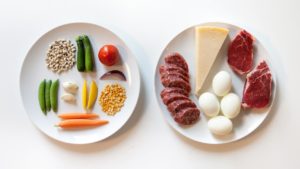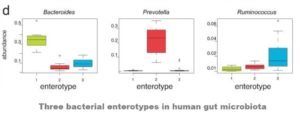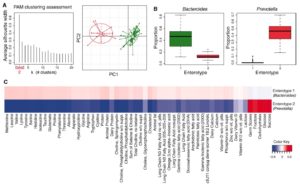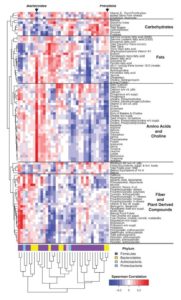
As pointed out in an earlier blog1 , there are thought to be over 40,000 different types of bacterial species within the trillions of microscopic microbes that make up the microbiota inside our guts. Some of these are friendly and some are most definitely unfriendly to their hosts – you and me. Recent research is supporting the hypothesis that all these species can be divided into two distinct groups – one group is encouraged by a meat-based diet, and the other is encouraged by a plant-based diet. But does one of these groups contain more friendly/unfriendly bacteria than the other?
To answer this we will look first at a major ground-breaking study2 which analysed the microbiota of individuals across several countries and continents. At that stage, the researchers identified three enterotypes. An enterotype is “a classification of living organisms based on its bacteriological ecosystem in the gut microbiome. The discovery of three human enterotypes was announced in the April 2011 issue of Nature by Peer Bork and his associates.”3
The idea that all these thousands of different bacteria should be shown to fit into just three distinct ecosystems or groups (see later for how these three groups are are subsequently reduced to just two) – irrespective of geographical location, age, gender, BMI, health status – is quite remarkable. The researchers considered it possible to split the whole of humanity into three groups, defined by a preponderance of one of the following three bacteria species:
- Bacteroides
- Prevotella
- Ruminococcus

This is, of course, rather astounding; but subsequent research4 with a larger sample of individuals found that Ruminococcus fold into Bacteroides, and so we all fit into just two groups – people who overwhelmingly play host to either Bacteroides species or Prevotella species.

Key to diagram: Clustering of gut microbial taxa into enterotypes is associated with long-term diet. (A) Clustering in the COMBO cross-sectional study using Jensen-Shannon distance. The left panel shows that the data are most naturally separated into two clusters by the PAM method. The x axis shows cluster number; the y axis shows silhouette width, a measure of cluster separation (12). The right panel shows the clustering on the first two principal components. (B) Proportions of bacterial taxa characteristic of each enterotype. Boxes represent the interquartile range (IQR) and the line inside represents the median. Whiskers denote the lowest and highest values within 1.5 × IQR. (C) The association of dietary components with each enterotype. The strength and direction of each association, as measured by the means of the standardized nutrient measurements, is shown by the color key at the lower right. Enterotype is shown at the right. Red indicates greater amounts, blue lesser amounts of each nutrient in each enterotype (complete lists of nutrients are in table S2). Columns were clustered by Euclidean distance.
Blog Contents
So what determines whether you fit into the Bacteroides group or the Prevotella group?
The foods you normally eat. Simple as that!
The following diagram shows how around 100 food elements were analysed to establish the ratio of Bacteroides to Prevotella species. The results were pretty astounding.
 The above chart is what’s known as a heat map:
The above chart is what’s known as a heat map:
- Each column is a different group of bacteria
- Each row is a food component (a dietary nutrient)
- Red (hot) indicates a strong correlation between the presence of a high level of a particular bacteria and a particular dietary nutrient
- Blue (cold) shows a reverse correlation (that is, very low levels of a particular bacteria in the presence of high levels of a particular nutrient)
So eating which foods results in which enterotype?
You’ll notice from the chart that with food components like animal fat, cholesterol and animal protein, the Bacteroides are red and Prevotella are blue, but with plant components such as carbohydrates, Prevotella is red and Bacteroides is blue.
Bacteroides and Prevotella do not exist in large populations within person’s gut at the same time. They are sort of opposites that don’t attract!
The results of this study clearly demonstrate that:
- the Bacteroides enterotype is found mostly in dietary components of animal foods
- the Prevotella enterotype is found pretty much exclusively in dietary components of plant foods
So, is one of these enterotypes better or worse than the other? I mean, is one of them associated with diseases while the other is not? Have a guess…
A subsequent study5 of colon cancer in rural Africans (those who eat mostly plants – Prevotella-friendly) and African Americans (those who’ve adopted the SAD and eat a lot of animal foods – Bacteroides-friendly) may have found the answer, at least in connection with the only disease they tested for – viz. colon cancer.
It may come as no surprise, therefore:
- the Bacteroides species has a strong association with increased risk of colon cancer (cancer being the second biggest leading killer in the USA)
- colon cancer in the Prevotella-rich native African population is almost never seen
It doesn’t seem like a great leap for imagination to consider that this basic difference in our gut microbiota is likely to explain why African Americans have more than 50 times the rate of colon cancer when compared with native Africans.
So, what’s on your plate?
Dr Greger covers this subject with an article6 and a video7 if you want his opinion and listen to his dulcet tones…
See Notes for an abstract of the latter native American vs African American study.
Notes
Diet, microbiota, and microbial metabolites in colon cancer risk in rural Africans and African Americans.5
BACKGROUND:
Epidemiologic studies have suggested that most cases of sporadic colon cancer can be attributed to diet. The recognition that colonic microbiota have a major influence on colonic health suggests that they might mediate colonic carcinogenesis.
OBJECTIVE:
To examine the hypothesis that the influence of diet on colon cancer risk is mediated by the microbiota through their metabolites, we measured differences in colonic microbes and their metabolites in African Americans with a high risk and in rural native Africans with a low risk of colon cancer.
DESIGN:
Fresh fecal samples were collected from 12 healthy African Americans aged 50-65 y and from 12 age- and sex-matched native Africans. Microbiomes were analyzed with 16S ribosomal RNA gene pyrosequencing together with quantitative polymerase chain reaction of the major fermentative, butyrate-producing, and bile acid-deconjugating bacteria. Fecal short-chain fatty acids were measured by gas chromatography and bile acids by liquid chromatography-mass spectrometry.
RESULTS:
Microbial composition was fundamentally different, with a predominance of Prevotella in native Africans (enterotype 2) and of Bacteroides in African Americans (enterotype 1). Total bacteria and major butyrate-producing groups were significantly more abundant in fecal samples from native Africans. Microbial genes encoding for secondary bile acid production were more abundant in African Americans, whereas those encoding for methanogenesis and hydrogen sulfide production were higher in native Africans. Fecal secondary bile acid concentrations were higher in African Americans, whereas short-chain fatty acids were higher in native Africans.
CONCLUSION:
Our results support the hypothesis that colon cancer risk is influenced by the balance between microbial production of health-promoting metabolites such as butyrate and potentially carcinogenic metabolites such as secondary bile acids.
References
- Depression is Linked to Inflammation [↩]
- Enterotypes of the human gut microbiome. Manimozhiyan Arumugam, Jeroen Raes[…]Peer Bork. Nature volume 473, pages 174–180. Published: 20 April 2011. [↩]
- Wikipedia: Enterotype. [↩]
- Linking Long-Term Dietary Patterns with Gut Microbial Enterotypes. Gary D. Wu, Jun Chen, Christian Hoffmann, Kyle Bittinger, Ying-Yu Chen1 Sue A. Keilbaugh, Meenakshi Bewtra, Dan Knights, William A. Walters, Rob Knight, Rohini Sinha, Erin Gilroy, Kernika Gupta, Robert Baldassano, Lisa Nessel, Hongzhe Li, Frederic D. Bushman, James D. Lewis. Science 07 Oct 2011: Vol. 334, Issue 6052, pp. 105-108. DOI: 10.1126/science.1208344, [↩]
- J Ou, F Carbonero, E G Zoetendal, J P DeLany, M Wang, K Newton, H R Gaskins, S J O’Keefe. Diet, microbiota, and microbial metabolites in colon cancer risk in rural Africans and African Americans. Am J Clin Nutr. 2013 Jul;98(1):111-20. [↩] [↩]
- What’s Your Enterotype?
Written By Michael Greger M.D. FACLM on May 1st, 2018 [↩] - What’s your Gut Microbiome Enterotype?
Michael Greger M.D. FACLM December 11th, 2015 Volume 28 [↩]